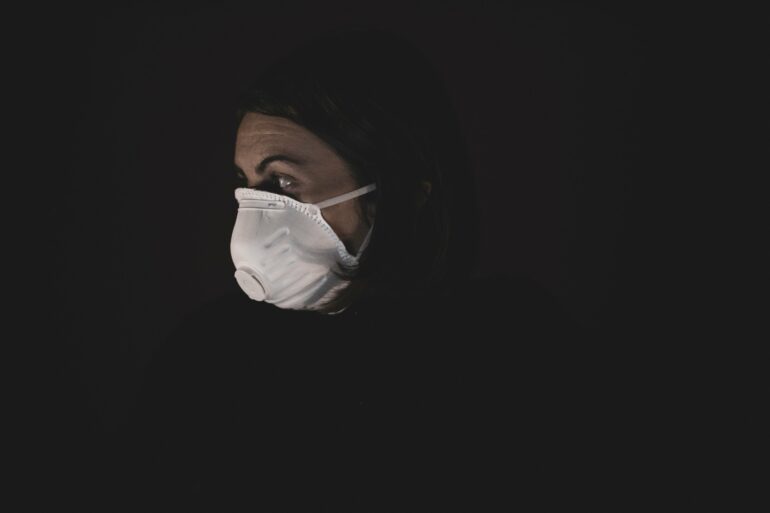In a head-to-head comparison of masks worn by people with active COVID-19, the inexpensive “duckbill” N95 came out on top, stopping 98% of COVID-19 particles in the breath of infected people from escaping into the air. Led by researchers from the University of Maryland School of Public Health (SPH), results showed other masks also performed well, blocking at least 70% of viral particles from escaping from the source—an infected person’s exhaled breath.
The study, “Relative efficacy of masks and respirators as source control for viral aerosol shedding from people infected with SARS-CoV-2”, was published May 29 in eBioMedicine.
“The research shows that any mask is much better than no mask, and an N95 is significantly better than the other options. That’s the number one message,” says the study’s senior author, Dr. Donald Milton. Milton is a UMD SPH professor of environmental health and a global expert on how viruses spread through the air.
The study started in May 2020, shortly after the pandemic began, and compared breath samples from volunteers who had active COVID-19, testing the performance of four commonly-used masks. Even without giving participants fit tests or training on how to wear masks correctly, all masks significantly reduced the amount of virus escaping into the air.
The study tested masks as a way to control the spread of the virus from the source, i.e. the infected person, and did not test masks as protection from COVID-19 in the surrounding air.
“Because COVID-19 is airborne, we focused on the extent to which wearing a mask reduces contamination of the air around you,” Milton says. This latest study is a continuation of investigations by UMD’s Public Health AeroBiology Lab (PHAB Lab) into how contagious respiratory viruses such as influenza contaminate the air.
Researchers asked volunteers with COVID-19 to breathe into a unique contraption known as the Gesundheit II Machine, developed by Milton and colleagues to measure viruses in exhaled breath. Participants, who breathed into the machine for 30 minutes at a time, were asked to do a variety of vocalizations such as repeating the alphabet, singing Happy Birthday, and even honoring UMD’s mascot by repeatedly shouting “Go Terps!”
In each instance, researchers measured the amount of viral particles in the exhaled breath of volunteers, pairing each 30-minute session of breathing with a mask on with another 30-minute session with no mask.
“Data from our study suggests that a mildly symptomatic person with COVID-19 who is not wearing a mask exhales a little over two infectious doses per hour,” says first author Dr. Jianyu Lai, a postdoctoral researcher at the PHAB Lab. “But when wearing an N95 mask, the risk goes down exponentially.”
The duckbill N95 blocked 99% of large particles and 98% of small particles from escaping out of a person’s mask. Milton says the design’s tight seal, a powerful filter, and large air space for breath to move around all contribute to the duckbill’s success.
Surprisingly, KN95 masks—the disposable masks used widely—were no more effective than cloth or surgical masks. The study found that a common brand of KN95 masks leak more air than duckbills or other studied masks, because they don’t conform to the face well. That flaw is compounded by a powerful filter with more flow resistance that pushes air out of the mask at the sides instead of through the filter, allowing more virus particles to escape into the surrounding air.
Cloth masks also outperformed both KN95 and surgical masks. Milton theorizes that cloth masks with greater coverage, wrap around the face and give a better seal than either KN95 or surgical masks. With cloth mask filters, flow resistance is also lower, allowing breath to pass through the filter and not leak out the sides of the mask.
Limiting the amount of viral particles in the air is a key way to control highly contagious respiratory viruses in general, Milton said. This is even more the case with the COVID-19 virus, given transmissibility has increased over time, with omicron in particular breaking through the immunity people developed from vaccinations or prior infections.
“Our research shows definitively why it’s so important to have non-pharmaceutical responses like wearing masks, and why we need studies like this to illuminate which masks are most effective,” says Milton.
Both Milton and Lai hope that their findings will inform health policies going forward, including when combating potential outbreaks like bird flu or even the common flu.
“Duckbill N95 masks should be the standard of care in high-risk situations, such as nursing homes and health care settings,” Lai says. “Now, when the next outbreak of a severe respiratory virus occurs, we know exactly how to help control the spread, with this simple and inexpensive solution.”
In addition to researchers from the UMD School of Public Health, collaborators include authors from the UMD A. James Clark School of Engineering and the World Health Organization Collaborating Center for Infectious Disease Epidemiology and Control at the University of Hong Kong, China.
More information:
Jianyu Lai et al, Relative efficacy of masks and respirators as source control for viral aerosol shedding from people infected with SARS-CoV-2: a controlled human exhaled breath aerosol experimental study, eBioMedicine (2024). DOI: 10.1016/j.ebiom.2024.105157
Provided by
University of Maryland
Citation:
Study shows N95 masks near-perfect at blocking escape of airborne COVID-19 (2024, May 30)



